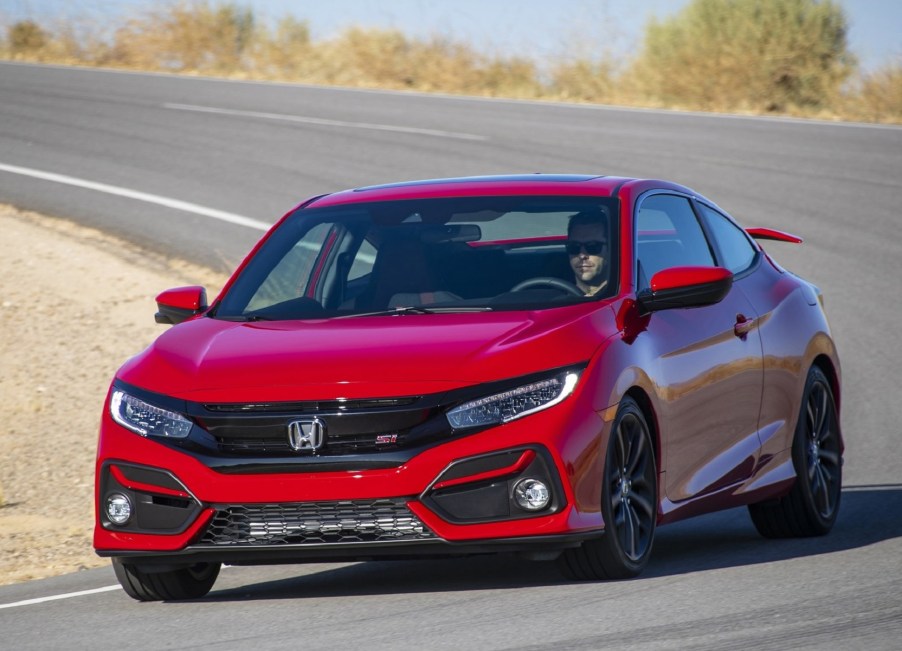
Is a Coupe Less Practical Than a Sedan?
While SUVs may have started supplanting them, sedans remain a popular vehicle choice. However, some people want the more stylish looks of a coupe. Hence the creation of so-called ‘4-door coupes’ (which are really sedans) like the BMW 2-Series Gran Coupe. But does going for a true 2-door coupe mean you’re giving up on practicality?
Coupe vs sedan: space
Generally speaking, Car and Driver explains, sedans have more space than coupes, due to longer wheelbases. And not just for passengers, either. The longer length makes for more cargo space, too.

Measuring and comparing space, for cargo or otherwise, in passenger cars and SUVs can be tricky, especially between manufacturers. That’s because different manufacturers can use different measurement standards. However, if we compare the same vehicle in coupe and sedan form, this minimizes, if not eliminates, these discrepancies.

In this case, let’s first look at the Honda Civic Sedan and Coupe. The former has, depending on the trim, as much as 15.1 cubic feet of cargo space. The latter, though, has either 11.9 or 12.1 cubic feet.
It’s a similar story with the rear passenger area. The coupe’s sloping roofline may be stylish, and its smaller dimensions make for less weight as well as better handling and braking, Carmax reports. However, the sedan has more rear headroom, legroom, and shoulder room. The only place where the Honda Civic Coupe is ahead is the hip room.

And this carries over to other manufacturers. The Dodge Challenger and Charger, for example, share the same platform and many of the same powertrains. However, looking at their Hellcat Widebody trims, the Charger has more interior volume, rear legroom, rear shoulder room, and rear hip room.

In addition, sedans have 4 proper doors, while coupes only have 2. Fewer doors do make the latter more rigid, CarsGuide explains, which again improves handling. But more doors make ingress and egress easier. Which is why the Mazda RX-8, with its rear ‘half-doors,’ is oddly practical.
Coupe vs sedan: safety, purchase cost, and insurance
Smaller passenger cars do face increased risks from SUVs and trucks. However, there really isn’t a major difference in safety between a coupe and a sedan. For example, both the Honda Civic Sedan and Coupe are IIHS Top Safety Picks. And both models can be equipped with the same driver-assistance features.
In terms of purchase cost, sedans and coupes are fairly even. A base-trim 2020 Honda Civic Coupe, for example, costs $400 more than the sedan model. But it’s reversed for the Dodge Challenger and Charger: the sedan is more expensive.
There is a popular myth, Esurance reports, that coupes are more expensive to insure than sedans. However, that isn’t necessarily true. For example, The Zebra estimates a Honda Civic Coupe would cost about $1646 to insure. That’s the same estimate given for the 4-door sedan model.
Coupes are commonly driven by younger, more risk-taking drivers, so it can seem like they have naturally higher insurance premiums. But the biggest factors involved, Jerry explains, are the vehicle’s safety rating and safety equipment, and the driver’s record.
What about a hatchback?

So, in terms of practicality, the sedan’s biggest advantage is space. But, if you want something that’s stylish with some more practicality, there’s also the hatchback.

The Honda Civic Hatchback may be more expensive than the other models, but it has more rear cargo space. That rear hatch also makes loading and unloading easier. And the sportiest Civic, the Type R, is only available in hatchback form.
Follow more updates from MotorBiscuit on our Facebook page.


